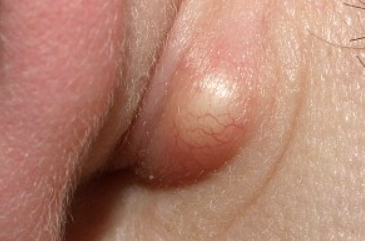An epidermoid cyst is a true cyst, representing a dermo-hypodermal tumor-like formation. ICD-10 code: L72.0
These formations can occur regardless of gender and age; they can develop in both children and adults, but are most commonly found in young and middle-aged individuals. Epidermoid cysts are the most common type of skin cyst. They form when a closed cavity in the dermis is formed from the epidermis or the epithelium of hair follicles and is filled with keratin and sebum. Epidermoid cysts can be congenital, traumatic, or inflammatory.It is characterized by the development of a slowly growing, often solitary, hemispherical, deep-seated and immobile tumor-like formation with an elastic consistency that is painless on palpation. The diameter of the cyst ranges from a few millimeters to several centimeters, but does not exceed 5 cm. It may protrude slightly above the surface of the skin, and an elongated follicular opening is often observed on its surface. The skin within the affected area remains unchanged or may have a whitish or yellowish color.
The preferred locations for epidermoid cysts are the hairy parts of the head, face, neck, and chest. Tumors frequently develop in the scrotal area, labia majora and minora, and there have been reported cases of localization on the palms and soles. If the cyst is located on the scrotum, it may become calcified. Solitary cysts are more common, but sometimes multiple cysts are encountered. In some cases, the cavity of the cyst is connected to the surface of the skin by a narrow channel, the opening of which is usually filled with a keratinous plug.
The contents of the cyst, including keratinous masses and sebum, have a pasty consistency, creamy color, and an unpleasant odor resembling rancid cheese. Epidermoid cysts are benign growths, although isolated cases of malignant transformation have been described.
Rupture of the cyst with release of its contents into the dermis may cause an inflammatory reaction followed by suppuration. In such cases, the cyst increases significantly in size and becomes quite painful. This condition is called an inflamed (ruptured) cyst, and misdiagnosis of secondary infection is common when a cyst ruptures.- Dermoid cyst
- Atheroma
- Lipoma
- Trichoepithelioma
- Eccrine spiradenoma.

